It is time to head out to the fields and wetlands for duck hunting season. Kansas has several popular duck hunting areas where ducks from Canada and the northern states migrate through on their way to the south. The Cheyenne Bottoms is one of the largest natural marshes in the US and attracts a variety of ducks and waterfowl. With the Missouri River on the northeast border and the Kansas River flowing through central Kansas there are many opportunities for duck hunting in Kansas. Here is everything you need to know about duck hunting season in Kansas including season dates, bag limits and more!
What Kinds of Ducks are in Kansas?

The three most common ducks harvested in Kansas are
mallards
, blue-winged teal and gadwalls.
©Kannan Sundaram/Shutterstock.com
The three most common ducks harvested in Kansas are mallards, blue-winged teal and gadwalls. You will also find a large number of wood ducks and a fair number of green-winged teal and pintails. There are 27 different duck species that have been identified as either residents or migrating through Kansas.
Where can you Duck Hunt in Kansas?
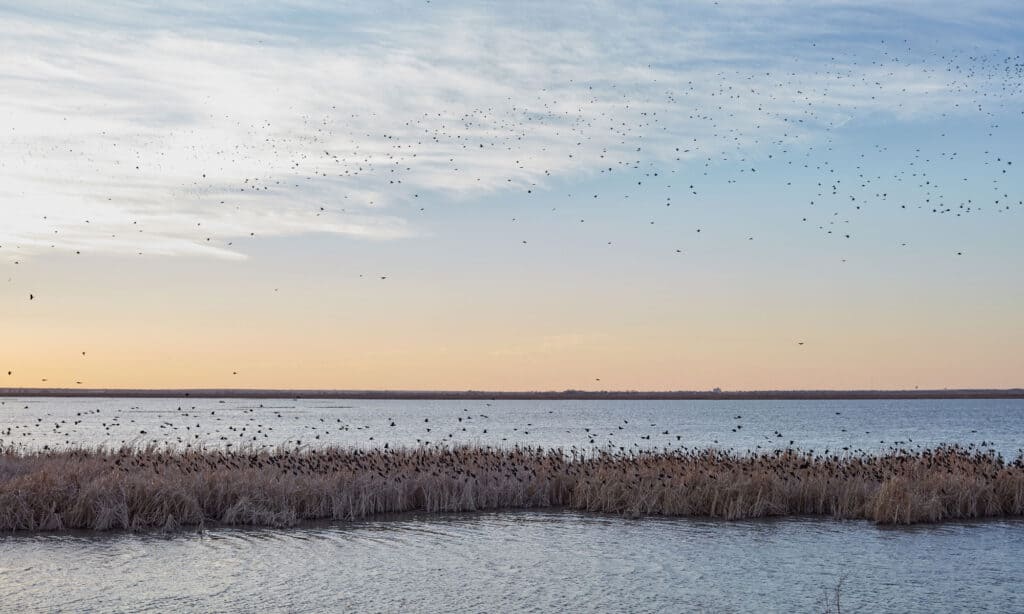
The Cheyenne Bottoms is over forty thousand acres of internationally significant wetland complex supporting an extremely diverse landscape for a wide range of reptiles, mammals, birds, and amphibians.
©iStock.com/Colby Lysne
The most common area for duck hunting is Cheyenne Bottoms Wildlife Management Area in central Kansas. This is the largest natural marsh in the United States with around 41,000 acres of land. Millions of ducks and migratory birds stop here during their migrations. Other arear for duck hunting in Kansas are the Jamestown Wildlife Area in northcentral Kansas and the McPherson Valley Wetlands Wildlife Area. McPherson has two refuges that are managed intensively for waterfowl. Duck hunting on private land is also an option but you do need to have the owner’s permission.
What are the Hunting Zones in Kansas?
Kansas has is divided into two main zones with the High Plains Zone on the west and the Low Plains Zone on the east. The Low Plains Zone is then divided further into the Early Zone, Late Zone and Southeast Zone. The map can be found here at the Kansas Department of Wildlife and Parks.
Duck Hunting Season Dates in Kansas
| Teal (blue-winged, green-winged and cinnamon)Ducks, Mergansers, and CootsHigh Plains ZoneSept. 17, 2022 – Sept. 25, 2022 | Oct. 8, 2022 – Jan. 1, 2023 | |
| Low Plains Early Zone | Sept. 10, 2022 – Sept. 25, 2022 | Oct. 8, 2022 – Dec. 4, 2022 |
| Low Plains Late Zone | Sept. 10, 2022 – Sept. 25, 2022 | Oct. 29, 2022 – Jan. 1, 2023 |
| Low Plains Southeast Zone | Sept. 10, 2022 – Sept. 25, 2022 | Nov. 5, 2022 – Jan. 1, 2023 |
Other Season Dates
| Youth, Veteran and Active Duty Waterfowl Hunt | |
| High Plains Zone | Oct. 1, 2022 – Oct. 2, 2022 |
| Low Plains Early Zone | Oct. 1, 2022 – Oct. 2, 2022 |
| Low Plains Late Zone | Oct. 22, 2022 – Oct. 23, 2022 |
| Low Plains Southeast Zone | Oct. 29, 2022 – Oct. 30, 2022 |
Bag Limits and Possession Limits for Duck Hunting in Kansas

The bag limit for ducks in Kansas is 6.
©Brian E Kushner/Shutterstock.com
The bag limit for ducks in Kansas is 6 with a possession limit three times the bag number. Note the restrictions on specific species and genders below.
| Species | Bag Limits | Possession Limits |
| Ducks* | 6 | 18 |
| Mergansers (no more than 2 hooded) | 5 | 15 |
| Coots | 15 | 45 |
| Teals | 6 | 18 |
*6 ducks, which may include no more than 5 mallards (only 2 of which may be hens), 3 wood ducks, 2 redheads, 2 canvasbacks, 1 scaup and 1 pintail. The daily bag may comprise 6 of any other duck, such as 6 teal, 6 gadwall, or 6 wigeon.
What are the Shooting Hours?
The shooting hours in Kansas are ½ hour before sunrise to sunset.
Gear up! What is the Best Gear for Duck Hunting?
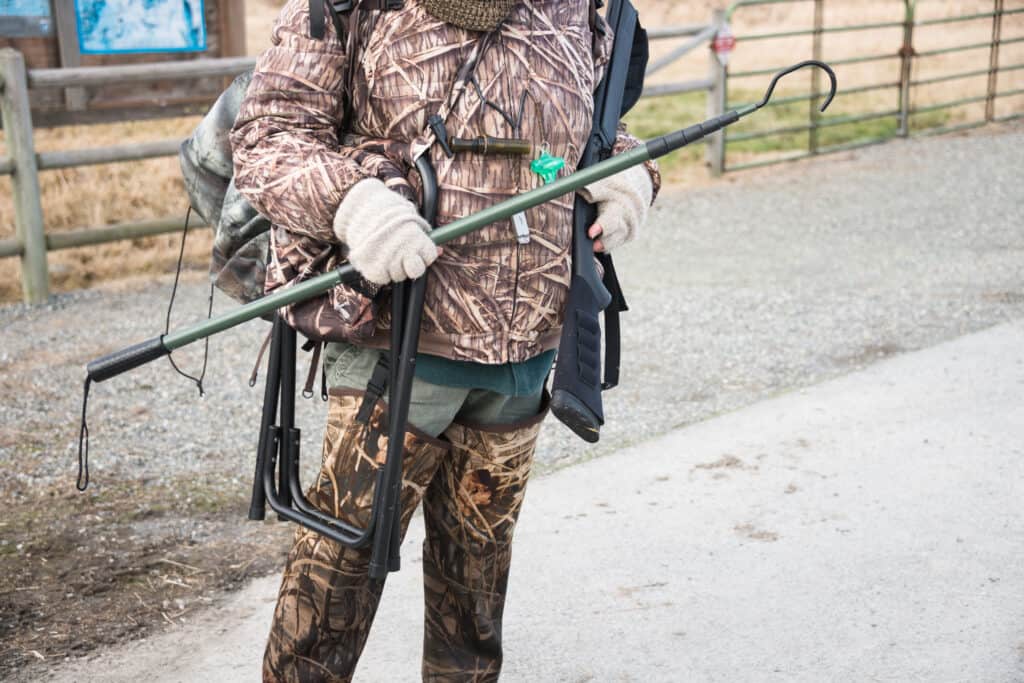
The right gear can make a big difference between a miserable cold, wet, duckless day and a well prepared exciting day of meeting your bag limit.
©Denise Lett/Shutterstock.com
You don’t need a lot of gear to go duck hunting, especially if you’re field hunting vs taking a boat out. But there are a few things that attract ducks better and make for a more comfortable hunt. Here is a list of gear you will need for duck hunting in Kansas:
- Shotgun: a 12 gauge or 20 gauge, can only hold three shells
- Shells: 3” shells are common, shot must be nontoxic
- Gun case/bag/sleeve: waterproof is a must
- Decoys: You don’t have to hunt with decoys but it certainly helps draw flocks in. The decoys today are very realistic looking and lightweight. Research different patterns to set your spread, like the fishhook or “L” pattern making note of the wind direction and location of your blind.
- Duck callers: Not only should you have a good caller, you should know how to use it. Practice your duck calls so that by the time your hunt day arrives you are confident and ready to call. If you get really good you could head down to Arkansas for the annual World Duck Calling Championship!
- Cooler: Bring all the food/drinks you need for the day, and then a little extra just in case you need to stay “just one more hour”. Packing a thermos full of hot chili or soup is nice for late season hunting, snacks like beef jerky, peanuts and granola bars will provide a quick protein punch to keep you going.
What is the Best Blind?
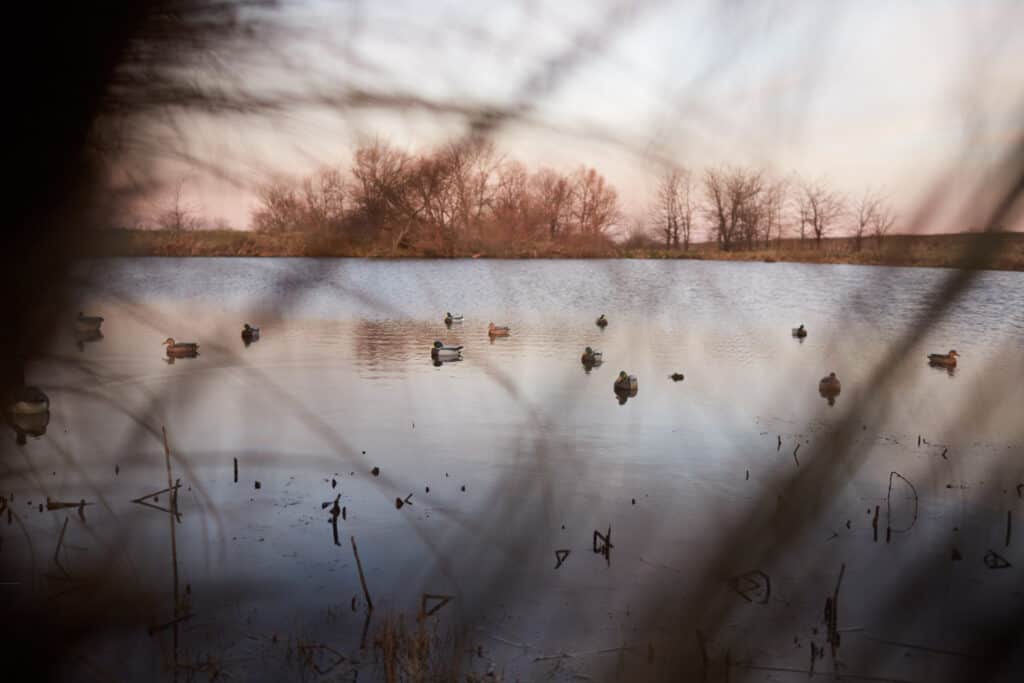
If you are planning a more extensive hunt or are hunting with a larger party you really do want to have a quality blind.
©CLP Media/Shutterstock.com
All duck hunters probably have advice on the “best blind” but there really are a variety of blinds that are really great depending on the kind of hunting you prefer. If you will be hunting in shallow wetlands like Cheyenne Bottoms then you might just need a layout blind (a sleeping bag like blind that you put on the ground). For areas with taller vegetation or on the banks of rivers and ponds you can use an A-frame which are tall enough for you to stand up in. Some are quite large and can accommodate several hunters and their dogs. The key is to have a blind that is super camouflaged. Even if you choose to make your own on site, always use more vegetation then you think is “good enough”.
What Should you Wear Duck Hunting?
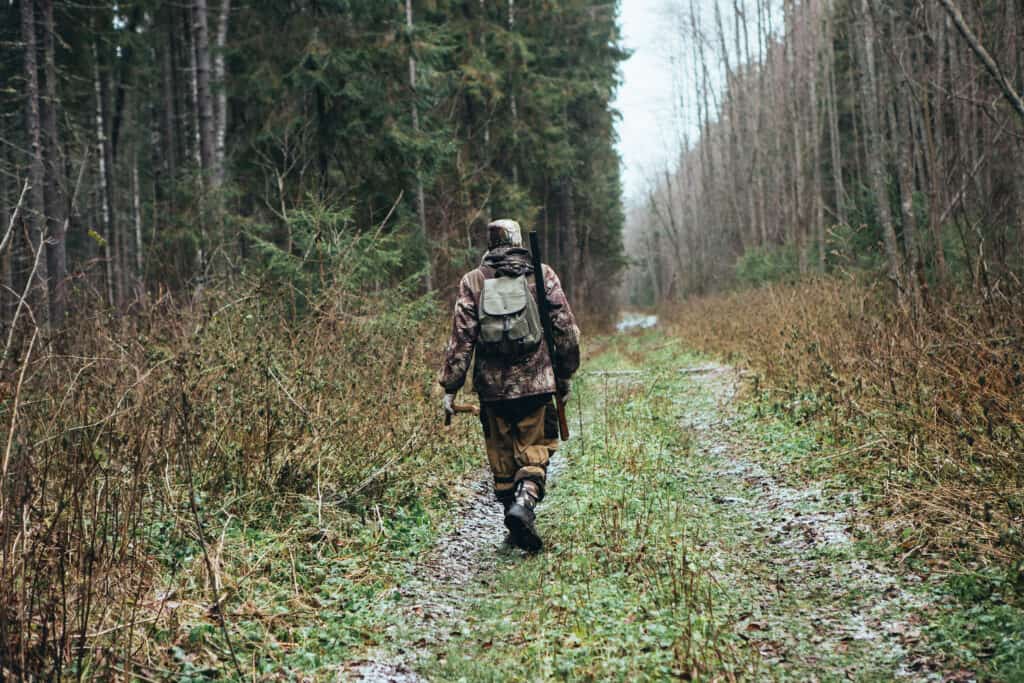
Duck hunting has a reputation for being gear heavy, but it doesn’t have to be.
©Scharfsin/Shutterstock.com
Hunting in the southern Low Plains Southeast Zone in September is very different than hunting in the northern High Plains Zone in mid-December (Brrrr!). You want to dress for the weather. Here are some of the things you should wear:
- Boots: Investing in a good pair of boots is really important. The warmer and more waterproof the better.
- Waders: Warmer and more waterproof applies to your waders as well. They do make one-piece wader-boot combos which are nice for keeping dry. Some waders also come with a removable liner so you can use them early and late season.
- Camo: Just as todays decoys are so realistic, today’s camo designs are life-like and really fit different habitats. Decide where you plan to hunt first so you can get the most realistic matching camo.
- Life vest or PFD: Not all of the duck hunting areas in Kanas are wade-in. There are plenty of opportunities to for launching your boat, canoe or kayak to get to the luckiest hunting holes. If you do plan to be on a boat you need to have a life vest. Choose one that is specifically made for duck hunting.
Hunting with your Dog
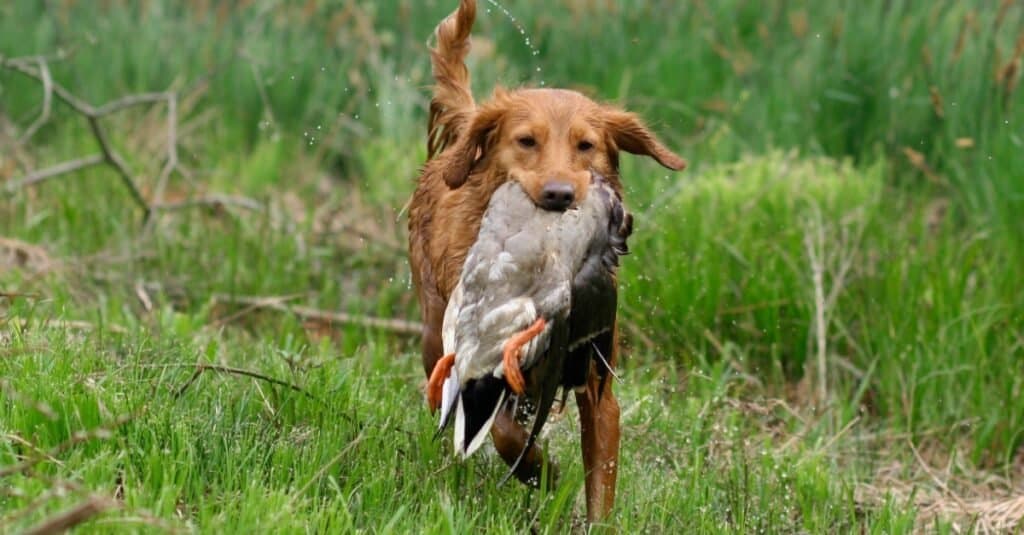
If your dog is a key player in your hunt remember to have all the gear they need as well.
©iStock.com/Azoogle
It can be very rewarding to go hunting with your pup. Especially after years of training and learning to hunt together. If your dog is a key player in your hunt remember to have all the gear they need as well. They make wonderful lightweight hunting vests for dogs and you want to make sure your dog has its own blind or will fit in yours. Bring a first aid kit as well and learn how to release your dog from a snare if you will be hunting in an area where trapping is also allowed.
Top Three Tips for Success
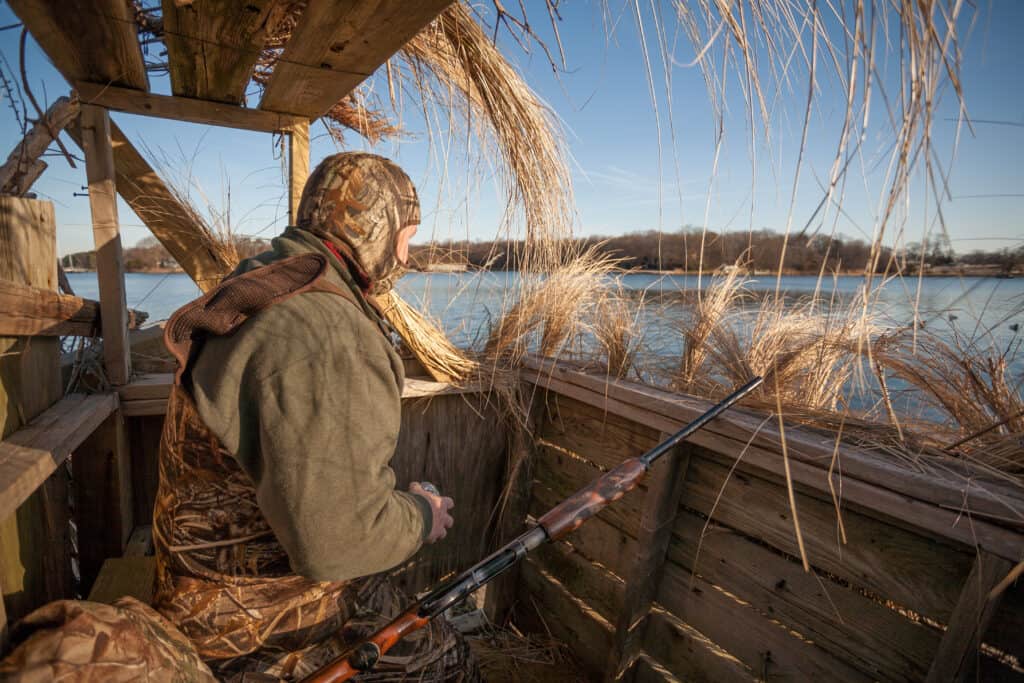
For private land you can build a permanent blind that you can use as a family and pass on to younger generations.
©Brian N Rogers/Shutterstock.com
1) Scout: The first tip is to scout…then scout some more for the best area for hunting at the time of your hunt. Don’t just rely on last year’s lucky spot or that time you bagged your limit by 8am. Driving around the day before a hunt to see where the ducks are hanging out is a great strategy. Reading the weekly waterfowl reports really does help locate the best place to set up shop on hunt day.
2) Blend: If you flew a drone over your blind what would it show? Would your blind and you (and your buddy) all be as camouflaged as possible? If not, you need to throw on a hat, paint your face, wear a face covering and add more cattails to your blind. The key is to blend in.
3) Watch the weather: Check the forecast a few days before a hunt so you can plan ahead. Not only for how you want to dress but also to factor in the wind to see if ducks will be stirring. The best weather for duck hunting is the opposite of the best day at the beach. Cool, rainy and windy are conditions that make ducks move and often fly a little lower for a nice shot.
Where are the Best Places to Duck Hunt in Kansas?

Some of the best places to duck hunt in Kansas are the wetland areas in central Kansas.
©Warren Price Photography/Shutterstock.com
Some of the best places to duck hunt in Kansas are the wetland areas in central Kansas. Ducks in the Central Flyway from Canada, North Dakota, South Dakota and Nebraska make their way south for the winter, making a pit stop in Kansas along the way. Some of the most popular areas for duck hunting are Cheyenne Bottoms, the Jamestown Wildlife Area and McPherson Valley Wetlands Wildlife Area.
Meet the Species: 3 of the Most Common Ducks in Kansas
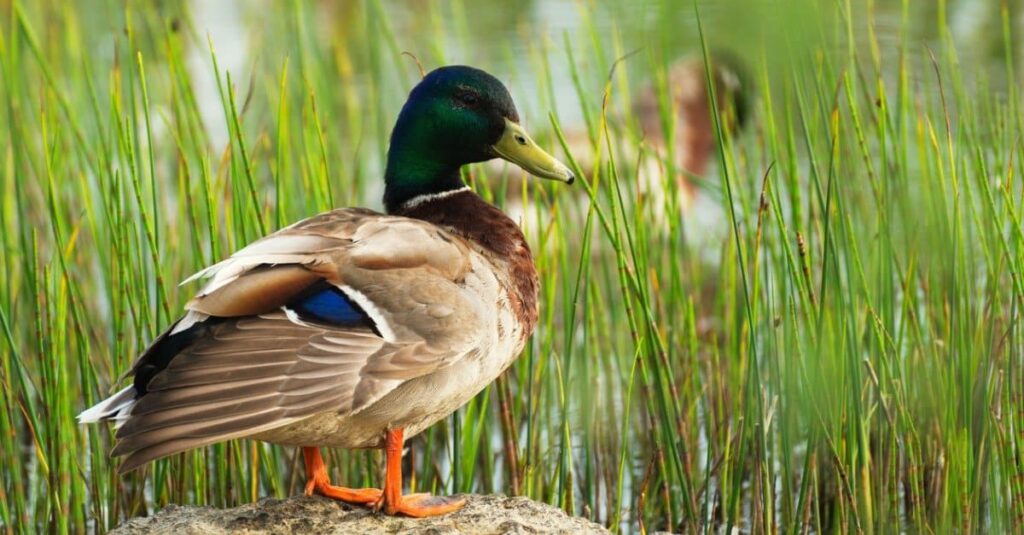
Instead of diving, mallards dip their heads into the water.
©iStock.com/M-Production
- Mallard: The most harvested duck in Kansas is the mallard. These are more abundant later in the season but they are easy to identify and probably what you picture when you hear “duck”. The males have a bright green head, yellow beak, orange feat and a blue patch on their lower wings. Females are less colorful, like most female ducks, with a patterned brown body and head with orange legs and the matching blue patch on the wings.
- Blue-winged teal: Teal are the first migratory birds to pass through Kansas with blue-winged, green-winged and cinnamon teal passing through as early as September. Blue-winged teal actually have a bright green patch on their lower wings (speculum) but the upper part of their wings are blue-gray.
- Gadwall: Mallards and wood duck are kind of flashy looking compared to gadwall but gadwalls are great for duck hunting. The males and females look similar with all patterned brown feathers. Their beak and tail feathers are both black and they have a white patch on their speculums.
Up Next
The photo featured at the top of this post is © iStock.com/Serrhel
Sources
- Kansas Department of Wildlife & Parks, Available here: https://ksoutdoors.com/Hunting/Migratory-Birds/Ducks
- Ducks Unlimited, Available here: https://www.ducks.org/hunting/waterfowl-hunting-destinations/five-fantastic-central-flyway-public-waterfowling-destinations
- Ducks Unlimited, Available here: https://www.ducks.org/hunting/waterfowl-id/gadwall
FAQs (Frequently Asked Questions)
Can you duck hunt in Kansas?
Yes, you can duck hunt in Kansas. You need a Federal Waterfowl Stamp, Kansas State Waterfowl Stamp and a HIP stamp.
When does duck hunting season start in Kansas?
The official duck hunting season starts Oct. 8th in the High Plains Zone and Low Plains Early Zone first with an early teal season beginning Sept. 10.
What are the most common ducks in Kansas?
The most common ducks harvested in Kansas are mallards, blue-winged teal and gadwalls.
What is the bag limit for mallards in Kansas?
Of the 6 duck limit, 5 may be mallards and 2 of those may be hens.
How does Kansas rank in the country for duck harvest numbers?
Kansas is ranked 19th in duck harvest (based on a 10-year average).
Thank you for reading! Have some feedback for us? Contact the AZ Animals editorial team.






